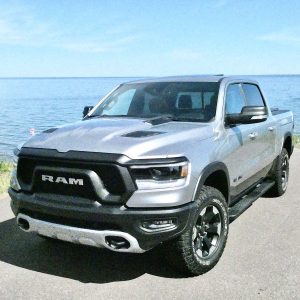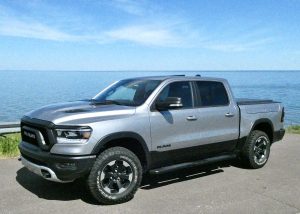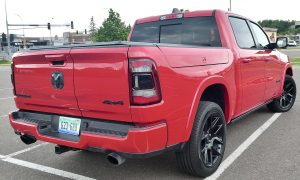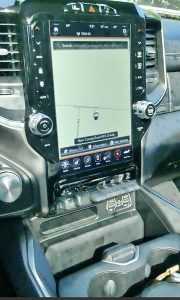Ram vs. Ram in pickup battle
By John Gilbert
One of the biggest success stories of the 2019 model year was the amazing upsurge in sales of Ram pickup trucks, which sailed right past the enigmatic Chevrolet Silverado to displace it the No. 2 spot behind the almighty Ford F-150.
Engineers and designers at Dodge had been doing a commendable job on the Ram before Fiat took over to create Fiat Chrysler Automobiles and establish Ram as its own division, but since then, Ram has established new heights for pickup style and sophistication.
Ram buyers have been quick to boast of their perceived superiority. Such elements as coil spring suspension in the rear, which makes the Ram by far the most comfortable to ride in on roads and highways, and constantly upgraded interiors, which set new standards for attractiveness as well as function.
It may be that Ram has no illusions about overtaking the Ford, but its array of models, loaded with impressive features, puts Ram on a high plateau that deserves evaluation by anyone looking to buy a big truck — a full-size pickup — for hauling stuff, towing stuff and carrying the family in comfort as well as safety and efficiency.
If auto sales followed election-year protocol, we could all vote by November 3 with our loan or lease budgets on which pickup truck is the best. As it is, the preference hinges greatly on family tradition. Whatever the process, the Ford F-150 traditionally wins the popular vote, over the Chevrolet Silverado, the Ram, Toyota Tundra, Honda Ridgeline, Nissan Titan, and midsize gems such as the Toyota Tacoma, Chevy Colorado and its GMC twin, Ford Ranger, and, if you can find one, a Nissan Frontier — plus, the newcomer on the scene, the Jeep Gladiator.
But Ram has upset the form chart to become top challenger for the F-150, and might be looking for more. For 2020, there is stiff competition within the Ram garage. It’s sort of like holding a national intramural tournament, while the varsity is on Coronavirus hiatus.
For example, the Ram 1500 Laramie Crew Cab 4X4 is the company icon, but what about the Ram Rebel?
The Laramie has a potent Hemi 5.7-liter V8 that delivers 395 horsepower and 410 foot-pounds of torque. The horsepower peaks at 5,600 RPMs, and the torque hits its peak at 3,950 RPMs.
The ride and interior accommodations are luxury-car-like — no other way to put it. The technology in this huge, Flame-red Ram is mostly unseen, such as the 5.7 V8 getting variable valve-timing and an electric boost from its E-Torque engine, using a mild hybrid input to help keep all the electrics charged. It also has an enormous, dual-pane sunroof that covers the front and rear seats. Along with the classy leather upholstery, the front is dominated by a large console and an enormous, iPad-size 12-inch center stack screen.
With all the safety and security features, the big Ram rides on 22-inch styled wheels, plays tunes through a 19-speaker Harman Kardon audio upgrade, and has a running board that promptly unfolds and drops down to help you in or out upon stopping and opening a door.
A 33-gallon fuel tank means that with fuel economy of 17 city and 22 highway, you can beat most of the competition and also not have to worry about frequent gas stops while you’re towing trailers of up to 12,750 pounds.
With a base price of $46,740 boosted up to $68,615 with all the features, the big Ram makes the case that if you’re going to spend a lot of time in your truck, you may as well enjoy every facet.
So what can the 1500 Rebel Crew Cab offer to compete with its big brother?
To begin with, my test Rebel, in Billet Silver Metallic, came equipped with the highly acclaimed, Fiat-sourced 3.0-liter EcoDiesel, a turbodiesel V6 — a Generation-3 version of that proven European engine. It runs quietly, and makes extraordinary power. For a V6, about half the size of the 5.7 V8, this EcoDiesel develops 260 horsepower and a whopping 480 foot-pounds of torque.

Extra ground clearance, armor-plated grille and skidplates underneath, make Rebel ready for off-roading.
Compared to the impressive 5.7 Hemi, the EcoDiesel’s horsepower peaks at 3,600 RPMs compared to the gas V8’s 5,600, and its full torque peaks at only 1,600 RPMs for 480 foot-pounds, compared to 3,950 for the V8’s 410 foot-pounds. The Rebel diesel also has the 33-gallon fuel tank, and boasts EPA estimates of 29 miles per gallon in highway driving and in city driving it matches the Hemi’s highway 22 miles per gallon. The Rebel towing maximum is 12,560 pounds — 210 pounds less than the gas V8.
Being the Rebel means it has black rubbery stuff protecting the grille and offering a menacing look in the process. It has fixed running boards, and skid plates underneath protecting the fuel tank, the transfer case and the front suspension, in case you want to go thrashing off-road.
Both vehicles share the safety and convenience items, including the big fuel tank and the high-powered audio, although the Rebel is nowhere near as luxurious as the Laramie, opting for a sportier
demeanor. That includes the very convenient storage areas in the sidewalls of the bed. To challenge Ford’s exceptional fold-down step for ease in climbing into the bed, Ram has a very neat multi-function tailgate, You can fold it down to open the entire width of the bed, or, by activating an alternative handle, you have a pair of side-opening doors, like an old-time saloon in the cowboy movies. That is very efficient for loading, unloading, and reaching in for stuff because you can get your body right up next to the vehicle.
I personally love the bright red on the Laramie, but the rich silver of the Rebel, with all that black trim, makes it a tossup, in my mind. Maybe I’d take the fixed running board and the skid plates of the Rebel. Tough choice. Ram may have a great idea: By offering two such impressive vehicles under the same badge, any potential customer may get caught up comparing the two and completely forget he was on his way to Ford, Chevy, and Toyota dealers for comparison shopping.








 John Gilbert is a lifetime Minnesotan and career journalist, specializing in cars and sports during and since spending 30 years at the Minneapolis Tribune, now the Star Tribune. More recently, he has continued translating the high-tech world of autos and sharing his passionate insights as a freelance writer/photographer/broadcaster. A member of the prestigious North American Car and Truck of the Year jury since 1993. John can be heard Monday-Friday from 9-11am on 610 KDAL(www.kdal610.com) on the "John Gilbert Show," and writes a column in the Duluth Reader.
John Gilbert is a lifetime Minnesotan and career journalist, specializing in cars and sports during and since spending 30 years at the Minneapolis Tribune, now the Star Tribune. More recently, he has continued translating the high-tech world of autos and sharing his passionate insights as a freelance writer/photographer/broadcaster. A member of the prestigious North American Car and Truck of the Year jury since 1993. John can be heard Monday-Friday from 9-11am on 610 KDAL(www.kdal610.com) on the "John Gilbert Show," and writes a column in the Duluth Reader.